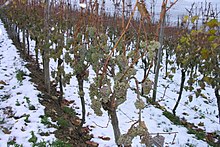(Ice Wine) Dessert wine obtained from frozen, ripe grapes.
Ice wine (or icewine; German: Eiswein) is a type of dessert wine produced from grapes that have been frozen while still on the vine. The sugars and other dissolved solids do not freeze, but the water does, allowing for a more concentrated grape juice to develop. The grapes' must is then pressed from the frozen grapes, resulting in a smaller amount of more concentrated, very sweet juice. With ice wines, the freezing happens before the fermentation, not afterwards. Unlike the grapes from which other dessert wines are made, such as Sauternes, Tokaji, or Trockenbeerenauslese, ice wine grapes should not be affected by Botrytis cinerea or noble rot, at least not to any great degree. Only healthy grapes keep in good shape until the opportunity arises for an ice wine harvest, which in extreme cases can occur after the New Year, on a northern hemisphere calendar. This gives ice wine its characteristic refreshing sweetness balanced by high acidity. When the grapes are free of Botrytis, they are said to come in "clean". This results in a very complex and sweet wine. Much ice wine is made from the grapes Riesling, Vidal, Cabernet Franc and Cabernet Sauvignon, but there is also ice wine made from Shiraz, Merlot, Sangiovese and others.

Ice wine production is risky (the frost may not come at all before the grapes rot or are otherwise lost) and requires the availability of a large enough labour force to pick the whole crop within a few hours, at a moment's notice, on the first morning that is cold enough. The grapes for ice wine must only be harvested when they are frozen naturally and the temperature must be -8 C (20°F) or below when they are picked. This results in relatively small amounts of ice wine being made worldwide, making ice wines generally expensive.
Ice wine production is limited to that minority of the world's wine-growing regions where the necessary cold temperatures can be expected to be reached with some regularity. Canada is the world's largest producer of ice wines, producing a greater volume of ice wine than all other countries combined, followed by Germany.

 Wineries
Wineries